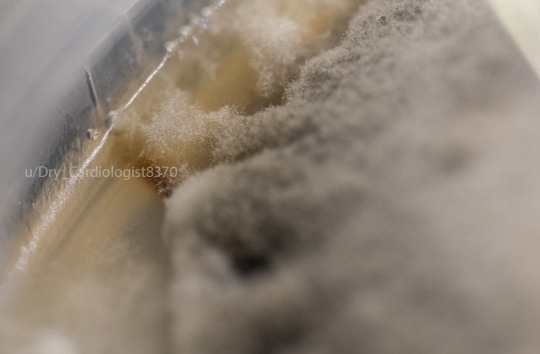#pscilocybe
Photo
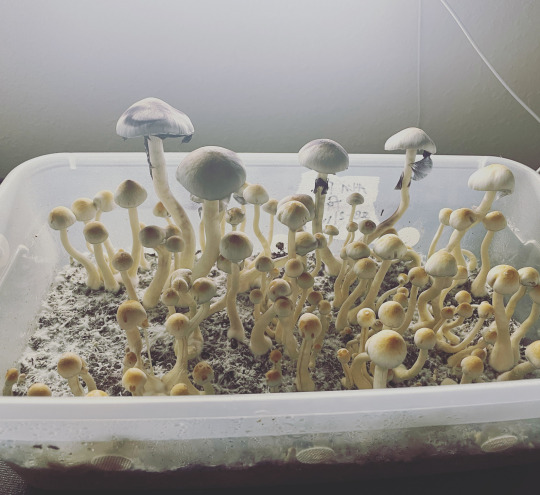

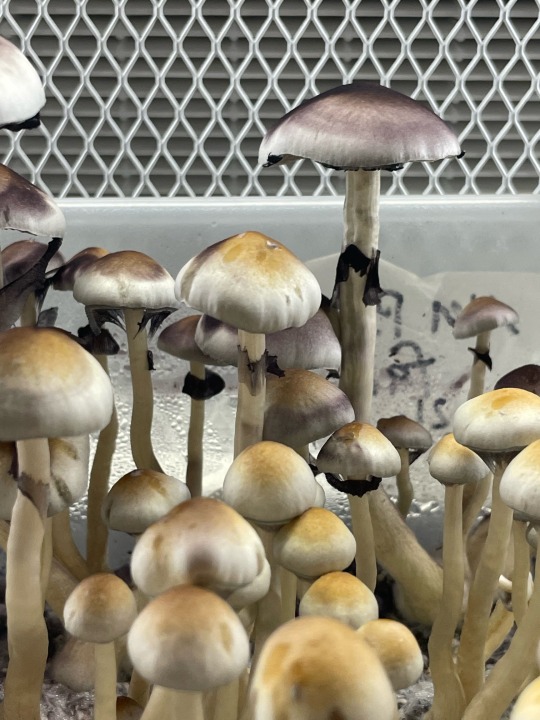

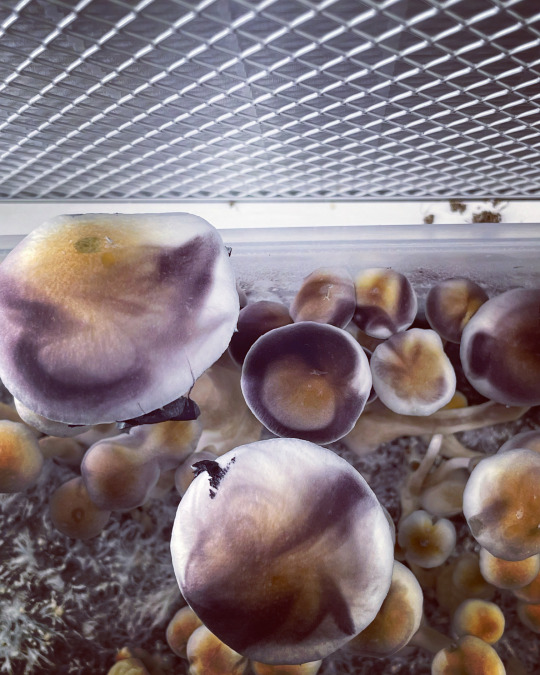
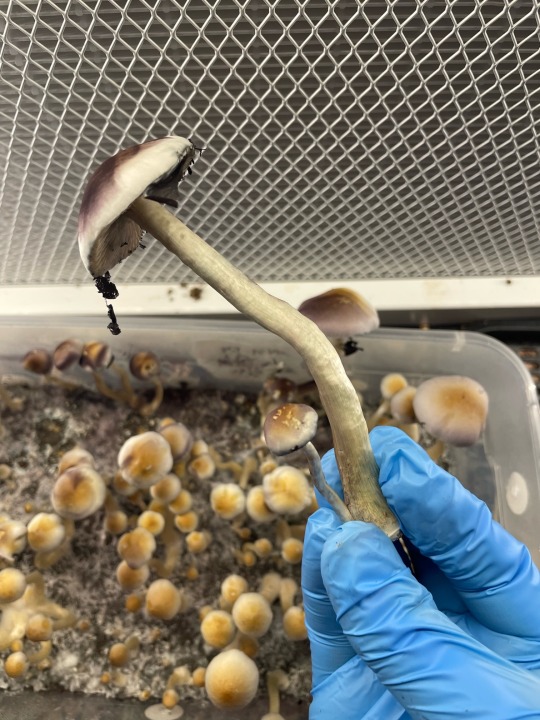
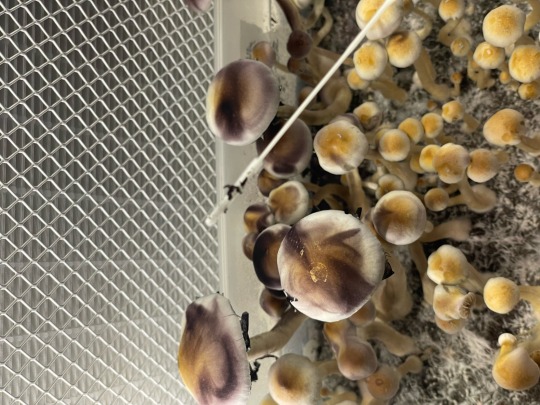




P. Natalensis, first flush of first tub - got some deformities, but I accept them into my harvest and stock like any other (as long as they arent rotted, or showing signs of contamination).
These fruits are very interesting in person... that attach lightly to the substrate, pulling up easily without tearing any substrate in large clumps.. like grass... the stipes are like... a pearlescent, shimmery white... and they actually FELT different in my fingers compared to p. cubensis varieties;
as I cover in an instagram reel, Natal is an isolated wild strain that has been confirmed as a separate, more contaminant resistant (and more vigorous) species Psilocybe natalensis (P. Natal).
The fruits matured fast, and sporulated within 6 hours (if not faster) of first noted veil break. The first photo in this set is 1 day before the rest of the photos in the set, for reference :)
Check my instagram for pics of the plates of the mycelium from these genetics... super, duper intense mycelium. Just... wow.
#myco#mycology#natal#p natal#natalensis#pscilocybe#psciloscin#gay#cute#love#mushies#magic mushies#enby#deformities
5 notes
·
View notes
Note
hi mycopal :) I'm enjoying your blog and admiring your set up, seems very hightech. I'm also reading about cultivating a local (Australian) psilocybin variety we often find in pine forests. Could you point me in the right direction for more info to get started with a simple at home set up for beginners? thanks again for your good work :)
Hello there mycopal! Thanks for reaching out! I appreciate your kind words :) I’m super proud of my lab area! It has taken two years to put together by saving 25-50 a paycheck lol!! Humorously my roommate doesn’t like that i commandeered a whole room … haha, but here we are ;) What mushy are you looking to cultivate? Pscilocybe Tampensis or P. subtropicalis maybe? :)
note: my opinions and advice are based on my own experience and studious research :) there are MANY ways to skin things with… skin… lol; as such, my way should work for most but may not and there are many other mycoeducators with varied approaches that offer great insight in their own right :) I have a few vids on youtube (still new to content creating there and working on adding more) if you wanna see more of what I do as I outline it below! At the end of this long winded MCX response I will provide supportive resources for your consideration in order they are addressed in this response.
🍄Tip: get some nasalpharyngeal swabs so you can actively swab and store mushroom genetics you find in the wild for later reararch ;)
Pretext: I live in a (technically) tropical area so what i do with my research areas may be different than you! I am not sure how much of what im about to detail has been considered by you… but if youve considered it then disregard :) i like to break things down like you’re new new new incase theres any detail to miss.
Introductory Answering your Q: Basically you have to consider a handful of generalized steps for cultivating any fungus; and find TEKs (ie: guides by other mycopal’s that have yielded them success) and make your own tek— I always say that the mycojourney is coming up with your own tek, cobbled together from current teks that speak to you and also are appropriate for your resource availability :) after you get through my response you’ll have homework of studying resources but also: finding TEKs for your specific strain you want to work with :)
My preferred supplies-
Genetics: Dont know about the laws and availability where you live, but formal vendors (like innoculatetheworld ; sporeworks) and informal mycoeducators (who sometimes vendor spores) like PGT and Boomershroomer; are the only spore sources I trust (outside of my own stock;).
Boomershroomer makes quality inflatable monotubs and if you order one of her tubs she sends genetics with it! A little ‘secret’ ;) to be aware of!
PGT has a shop online thats only open sometimes but has a cool collectible trading card system for his genetics (buy the card get the microscopy supply with the card).
ITW and SW are generally up 24/7 and are more formal vendors that also sell microscopy stuff.
I currently use and recommend using 6qt shoebox totes for grow container (the kind that you buy in 5-10 packs from Walmart that have gusseted lids that allow some air flow for ‘sneakers’ to be stored hehe). Note that you can use 12/24/48/72qt etc, but I have no experience with those and they require larger set ups with fans, humidifiers, etc. i prefer less is more :)
I always promote a company called Microppose :) they do amazing filters and just started their own monotub production I think :) my fave substrate is CocoBliss coconut coir pith, and I use lab grade nutritional additives like: gypsum, lime, malt extract, and yeast off amazon in various stages of my process. For grain bags, before I made my own, I only trust: spawnmagic.com ; for my grains I use Producers Pride: Whole Oats (like what is given to horses) from the feedstore :) a 50lb bag has lasted me two years, no lie. I dont use bags, but jars for grain: i use brand: Ball, glass mason jars for spawn containers prior to moving spawn into a tub with substrate. I use Aozita wide mouth masonjar plastic lids (off Amazon) for my jars as they can be modified with filters and then pressure cooked safely and come with rubber seals :)
Now to go into detail to answer your question:
Here we go-deep breath-: lets talk cultivation and research starting:
1. Genetics: (a) multi spore syringe (mss) (can be injected into a grow bag but isnt ideal and may not produce viable strains) (recomended to use mss on agar to isolate your own colonies), (b) spore print/swab (requires agar) or (c) liquid culture (LC) isolate syringe (best option for immediate injection-inoculation of grain containers/bags with best chance for healthy growth and fruiting without time and hassle of the steps I outline further :)
1a. If you are able to work with agar (either make your own or buy premade sterilized, one time use agar plates): then you will start your journey by MSS->Agar->Isolate separate germinating colonies off mss agar plate to new plates (those become your mother isolate plates for each specific strain isolate for whatever strain youre working with). The mother plate should become your cold storage, reference plate as you study growth and fruiting characteristics of the colonies you isolate :) at that pont: You can then use some excised pieces of the mother plate (if in a rush, or if able to wait, till gen1 plates (transfers from mother plate to new plates that become duplicate isolates of the mother plate)) to inoculate a jar or two and also inoculate other plates to continue to ‘run the mycelium out’ / ‘chase the mycelium’.
1b. If you are not able to do agar work then I strongly suggest you seek genetics that are LC syringe. Basically, LC syringes are when mycopal takes a 2nd gen+ plate and moves some of that mycelium to sterile sugar water and lets the mycelium grow out in that water till its all filled with reproduced mycelium and can be sucked up into syringes for better more assured propagation of genetics ;)
Side thought: Spore swabs and spore syringed are dice rolls :) [Spore germination discussion incl quote from TMC- https://at.tumblr.com/mycochaos/uscrybal-commented-on-a-comment-i-made-quoting/pjzr0c86nlyt]
2. Grain spawn: once you have genetics hammered out, next is grain spawn. Grain spawn can be … well, any grain. Really. Mushrooms can colonize and fruit off of wet cardbord… 💯🍄😂, so what “type” of spawn is more about whats available in your area imo. Youll need to sterilize any grain spawn, unless using a premade bag thats already sterilized or taking chances with uncle bens (or similar) rice baggies that arent sterilized but are arguably cleaner than grains scooped out of a bags of grains from a mill or feedstore.
2a. Grain bags: milo, millet, rye berries, corn kernals, rice, whole oats, really any grain or berry that has a husk can be used :) some species prefer specific grains most work on all kinds of grains with varying levels of efficiency. Some grains are more or less robust and some do better when moistened and or pressure cooked than others :) i make my own grain but exclusively use glass mason quart jars :)
2b. Grain jars: my preference. I have recent grai. Jar prep and creation reels/shorts on my instagram and some on this tumblr if you wanna see specifics :) generally I do 15psi, 10 minute venting, for 1.5 hours for my grain and I do not soak grains, only low boil them for 30 min to soften husks and extract some grain nutrients to then use that liquid ‘grain soak’ run off for agar nutrients :)
2c. Uncle Bens rice bags: i dont do this and dont have any good advice on it. I have a UB tek link or two at end for consideration and there is a whole reddit mushroom sub i think r/unclebens (?) for this
2d. All in one bags: i also do not use these and do not recommend them generally. If you have never had a flush and are literally first timing it, then all in one may work fine :) but as much of the process you can source or create yourself the cheaper and often better, imo!
3. Substrate & Spawn-to-bulk (S2B): many mycopals have their own substrate preferences, but for me I prefer shaved coconut coir pith. I generally do a coir block 650g, 500g vermiculite (from garden store), and 50g gypsum + 50g lime for my substrate. I do not sterilize it, but I do heat pasteurize my substrate for at least 12 hours. In an air tight, insulated cooler (like for sodas at a party). You can also cold pasteurize. I like how Boomershroomer and PGT do their sub and learned from them then tweaked it for my own preferences :)
When my jars are fully colonized and observably free from contam, I will S2B using a clean butter knife :) I kinda cut down into the grain in pizza slices then swirl the knife around as I let grains that spill out mix with my substrate and basically do 1qt spawn to 2qt of substrate, saving maybe 10-15% of the spawn and substrate till end to make a special psuedo casing layer once bulk of spawn and substrate are mixed and compacted. Then I do a last sprinkling of the remaining grain like a baby lasgana and cover that with substrate.
Casing layer explainer: A casing layer is a layer of material applied on top of the colonized substrate in mushroom cultivation. It can help improve yield, reduce certain types of surface contaminants, and maintain humidity around the fruiting bodies. In my experience, using an organic sphagnum peat moss mixed with lime powder and filtered water has produced successful tubs without the need for pasteurization or sterilization. Before I used that i just used left over substrate as a casing layer :) — While some species require a specific type of casing layer after substrate colonization, most do not require one. However, adding a casing layer can be beneficial for improving yield and humidity control.
There are different ways to apply a casing layer. Some people apply it as part of the spawn to bulk (S2B) process, while others apply it only after the substrate surface is fully colonized or slightly before pinning. Personally, I have used a casing layer when colonizing pasteurized wheat/rye straw to provide an even fruiting surface for mycelium. I have also experimented with an organic peat and lime dust casing layer (no pasteurization or sterilization), which has helped retain humidity and has not resulted in any contamination. Personally, I've worked some APEs in that past that had a casing layer applied in the same instance as the S2B occuring, essentially the compacted bits colonized faster than the looser casing layer. Where I always use casing layer, is if I use spawn to colonize pasteurized wheat/rye straw, if only to provide an even fruiting surface for the mycelium! But, even then... most cubensis can fruit solely on pasteurized straw, with no casing layer!
4. Colonization and Fruiting:
4a. Youll need to find a TEK based on whatever substrate container you settle on using :) what ive outlined so far is my own tek, using 6qt shoe boxes and the materials ive outlined above. The substrate chamber/container can be a flat container/tote or could be fruited out the top of a grain bag/all-in-one bag OR could fruit off the side of a bag (if its a species like Oyster mushies that prefer side fruiting). I personally use unmodified tubs and will leave lid on my tubs while colonizing and then take lid off and replace with cleaned, upside down, misted 6qt tub that rests on the edges of the right-side-up tub to create a mini climate that allows more passive air flow, allows light to filter in from high angles promoting fruits growing upwards towards the light. Light isnt needed until pinning, and is a secondary trigger to pinning but a primary factor in pigmentation of fruits and growth direction of fruits.
Colonization of most mushroom fruiting fungi is generally between 68-80F, every species and even some varieties within those species, may have specific temp needs. The way mycopals control for this is many things that I dont have to use fortunately :) ‘Martha Tents’ are something to consider. Some use heating pads and humidifiers depending on where they live and where they are compared to the sea💯. I dont have any experience with martha tents or doing more than using my home A/C, a closet, and a heppa room filter to control my temps in the closet and with lots of trial and error…. I now leave my home at 72F, my closet warms to about 74 with the door shut and a/c at that temp, so i let plates, jars and tubs colonize at 74F and then I will move the tubs to open closet with more air flow and is closer to 72F when I am moving to fruiting :) Ive tried to be clever in how I use my space… so i use wire racks and know higher up on the rack is hotter and less air flow whereas lower is cooler and often more air flow.
Something I havent really gone into yet in this response is about sterility, aseptic environments, personal and environmental hygiene. All important to condsider…
4a. Heres my explainer on that:
Strict aespetic and hygiene techniques are not 100% and even using fancy laminar flow is not 100% contamination free potentials! Common contaminant sources include airborne spores, dust, and environmental factors. Pets that roam around your cultivation area could carry spores on their fur or paws, which may be released when they move through your space. Additionally, some fungal contaminants, like Kahms yeast, can present in distinctive ways and there are dimorphic fungal molds that have one or more alternate morphologies, main dimorphism being mold with a secondary yeast form (whence the mold spores get into human lungs, for example with blastomycosis perhaps) as an alternative reproductive presentation within its life cycle (based on temperature and environmental variables). It's essential to understand that spores and other contaminant-genetic cells are incredibly tiny and (in the case of most spores) can suspend in the air, waiting for air currents, light, or vibrations to move them around. Wet spores and bacterial cells oftentimes require animal assistance or liquid splashing/spritzing/spraying to move around, but can often hitch rides of natural environmental variabes (currents of wind, water, dirt, etc). Humans also carry a range of bacteria and fungal organisms on their skin, which can contribute to localized environmental dust and potential contamination when working in hyper sterile or attempted hygienic environments while researching fungi :)
4b: Primordia, Pins and Fruiting: Pinning is a colony activity (that impacts all sides of your cake once colonized) that shifts metabolic processes of the mycelia to pinning and fruiting, this is why when you start getting heavy side pins you rarely get any flat-surface pins and fruits (all the energy goes into what pins form and fruit, first). Additionally, I believe my suggestions will be effective in controlling for environmental triggers to pinning, it is important to note that side pinning can also occur due to other factors such as genetics or substrate composition.

You can reduce the microclimate from being created that promotes side pins, during the process, by ensuring that the substrate is firmly compressed, once S2B occurs, and then sprinkled with a .25" casing layer of the same substrate material (or peat+lime casing). I press my base spawn+cvg mix firmly, and ensuring that the surface is even with least amount of inconsistently level substrate surface. This early compression, keeps the cake against the wall for as longer than doing little to no compression of your spawn+sub. You should ensure your colonizing mycelium isnt exposed to the same lighting you would for fruiting, but light is only a secondary trigger to pinning, FAE+Temp Drop+Humidity pooling/then drying are the primary triggers for pinning once colonization has completed.
5. Harvesting and Dehydrating: i twist and pull my fruits, some will cut at base, some will float their cake with water and then cut or twist and pull at that poimt :) harvesting is preferential imo. I dehydrate fruits 125F for 24 hours in Air Fryer o. Dehydrate mode :)
Resources and foundational TEKs:
Genetics: innoculatetheworld.com, sporeworks,com, boomershroomer.com, pgtmycology,com
Casing layer post w/screencaps: https://www.tumblr.com/mycochaotix/723941213220339712/mycochaos-oldacnt-plzfollownew-one-of-my
Growing gourmet (book): https://drive.google.com/file/d/1-CsyZenWzF8kHLviXM8pencZ4FAHDedh/view?usp=drivesdk
PF tek - Check this site out, gives a great layout of "PF TEK" and also BRF cakes as part of that TEK - https://www.fungifun.org/pmwiki.php/English/Pftek
HOw to make easy (cvg) bulk substrate (boomer shroomer): https://www.youtube.com/watch?v=7M6YHfaMyQ8&t=3s
how to make plates, slants, and LC - north spore - https://www.youtube.com/watch?v=a4bzQQkh71Q&t=487s
pgt LC basics - https://www.youtube.com/watch?v=gqwjUq31KgU&t=284s
Southwest mushrooms - mycelium grain spawn and LC - https://www.youtube.com/watch?v=rxlJJpu3O_g
How to sterilize equipment such as petri dishes - MIcrobehunter microscopy - https://www.youtube.com/watch?v=MVtEBtxkhGk
mycelium inoculation in the lab - southwest mushrooms - https://www.youtube.com/watch?v=Ng_Wq9PnEVI&t=560s
Mushroom Cultivation, how it should and shouldnt look: https://www.shroomery.org/forums/showflat.php/Number/17231150
Recognizing and dealing with contamination: https://www.shroomery.org/forums/showflat.php/Number/23130868
Sterilization vs Pasturization - http://www.differencebetween.net/science/difference-between-sterilization-and-pasteurization/
Mushrooms, Molds and Mycorrhizae: A Fungal Immersion Course Part 1 - https://www.youtube.com/watch?v=dD1IL2dBLQ8
Mushrooms, Molds and Mycorrhizae: A Fungal Immersion Course Part 2 - https://www.youtube.com/watch?v=_bam3tF_a7M
Mushrooms, Molds and Mycorrhizae: A Fungal Immersion Course Part 3 - https://www.youtube.com/watch?v=AiIUGGKjuwU
Mushrooms, Molds and Mycorrhizae: A Fungal Immersion Course Part 4 - https://www.youtube.com/watch?v=KLfwruf2xVA
Guide to Oysters, Gourmet, Freshcap - https://www.youtube.com/watch?v=EZAjz6bZjpg
Cooking Oyster mushrooms, TGS - https://www.youtube.com/watch?v=7qb2KF6kvhA
5 gallon bucket tek - oyster mushrooms - gourmet - https://www.youtube.com/watch?v=45b2t7fqhjA&t=60s
Mycophilia YT 'All About Aborts' discussion: https://www.youtube.com/watch?v=9C8x_32Saxg
Bacterial colony morphology - https://www.youtube.com/watch?v=4JZAFUPckUg
Mycelium morphology : how to select healthy mycelium when breeding mushrooms -- https://www.youtube.com/watch?v=leUpfsonVxc&t=1s
mycotrophic - agar xfers/sectoring off healthiest growth - https://www.youtube.com/watch?v=XMxGwkj9Wn4
DayTrippers Microscopy library of contam and healthy mycelium examples: https://www.reddit.com/r/ContamFam/comments/nnquol/microscopy_of_healthy_mycelium_and_contamination/
PH trich conversation pt 2 DT: https://www.reddit.ccom/r/ContamFam/comments/jldtuw/my_garden_of_contam_free_grow_it_is_all_about_the/
DayTrippers Trip Tips - apply PH casing layer to prevent trich: https://www.reddit.com/r/ContamFam/comments/m3unbr/daytrippers_trip_tips_video_tutorial_on_how_to/
Trich contamfam library: https://www.reddit.com/r/ContamFam/comments/115gyj2/trichoderma_the_green_monster/?utm_source=share&utm_medium=web2x&context=3
If FAE is a problem: not pinning, getting Cobweb, Stroma Overlay! “READ THIS”: https://www.reddit.com/r/ContamFam/comments/jur5ar/daytrippers_trip_tip_why_cant_i_get_this_if_fae/
DayTripper’s Trip Tips: Two cultivation tricks to solve common problems of insufficient Fresh Air Exchange and Overlay growth in monotubs: https://www.reddit.com/r/ContamFam/comments/10w1yxm/daytrippers_trip_tips_two_cultivation_tricks_to/?utm_source=share&utm_medium=web2x&context=3
#mycology#lgbtqia2s#magic mushies#microbiology#mold#60s psychedelia#lgbtqia#lgbtqia2s+#myc#enby#myco#fungi#fungusamongus#fungus#funthey#funthem#nb#non binary#psychedlia
13 notes
·
View notes
Text
Okay to anyone that's listening
Ahem @taylorswift
Gaia is pscilocybes around humans
They like shrooms
They like herb distillates
They like miracle grow
They like attention and love
They want help
She is full to the brim of love but is dying
1 note
·
View note
Text
The offerings and a Fun Guy
Uploading part 2 of this however that will be more about the navigation and things to consider if you do not have a guide, maybe some things to do.
My new @patreon will have an expansion pack on that meaning more passed on teachings of the shamanic
3 notes
·
View notes
Text

Deseo perderme en esos tus laberintos, por un momento, sin que me importe a donde podrían llevarme.
.
.
.
Hongo del genero Pscilocybe.
1 note
·
View note
Text
Psilocybe Cubensis History/Taxonomy List by Taylor Yates of SporeSwaps
*This is an estimated/working list, not every known variety will be here and some information may be incorrect. New varieties are constantly being isolated, named, and/or crossed. Please note that this list may have multiple mistakes in it, all of the origin and historical information on this list is what we found in our research to be the most credible and believable. All of this information is supposed, if it’s not from the originator themselves. Most if not all originators/iso’ers were reached out prior to releasing this list for permission and clarification of their work and name. If there are any mistakes, we do apologize, please reach out to a SporeSwaps admin to resolve and fix any issues in this list. If you have any other information of differing stories or origins of any of these varieties, please reach out as well. I would also like to note, the term landrace iso refers to a variety that was originally found/collected in the location in which it is named. Mush love to all, and to all, love mush. - Taylor Yates*
● A+ (A-Strain)- originally marketed by Ralphsters Spores, also known as A-Strain
● AA+ (Albino A+)- mislabeled albino, leucistic A+ supposedly originating from Ralphsters Spores
● Alice- AA+ iso, unknown originator
● Acadian Coast- reportedly isolated from Louisiana coast
● Alamo- Albino Amazonian, iso’d by James Block and Jason Redman
● Alacabenzi- supposedly a hybrid of ‘Golden Teacher’ Cubensis and Psilocybe Mexicana, unknown
originator
● Albino Chodewave (ACW)- albino iso of OG Chodewave credited to Uncle J, PJ Holder, Dustin Fischer, Eric Gillium, and Adam Toney
● Albino Monkey Dick/Dong (AMD)- APE iso by Nichy Myco and Suzie Greenberg
● Ajax- little to no information was found about this variety at all. It is mentioned in early
blog threads, so it is suspected to be an OG almost lost variety
● AMAK (Albino Melmak)- a true albino Melmak TP iso by Dave Wombat
● American Mystic- MagicMyco cross of PE6 x Purple Mystic
● AMVP- albino TAT x Melmak cross by Jik Fibs and Dave Wombat
● APE- albino PE, apparently originated from Sporeworks and/or Shroomery user Workman, some say APE is a cross of PF Albino x PE and others say it is an albino iso of PE, an albino PE iso is most credited as correct
● APER- APE revert iso by Jake Oncid
● Argentina- landrace from Argentina
● Australian- apparently iso’d from a wild fruit in southern Australia, these rumors are
not confirmed however
● Avery’s Albino- iso’d albino Cambodian by Albinous White and Robert Young
● Aztec God- a Mexican variety, unknown origin suspected around Mazatec
● B+- commercialized cube by Mr. G, originally marketed as a Cubensis/Azurescens hybrid
● Ban Hua Thanon (BHT)- from John Allen, Thailand
● Ban Nathon Dhupatamyia (BND)- from John Allen, Thailand
● Ban Phang Ka (BPK)- from John Allen, Thailand
● Ban Thurain (BT)- from John Allen, Thailand
● BeePee- B+ x PE cross, not related to TidalWave or MagicMyco
● Bilbo- TAT x Melmak cross iso by MycoMama Angela and Fahthyr O Blivion
● Blue Jay- TAT x Melmak iso by Jik Fibs
● Blue Magnolia Classic (BMC)- originally iso’d by two Shroomery users from Mississippi
● Blue Magnolia Rust (BMR)- rust spored iso of BMC, by Mycotopia user Cue? questions over originator
● Blue Meanie (cube)- named by Keeper after Pan Cyan nickname, many say this was just a marketing loy
● Blue Moon- TAT x Melmak cross iso by Jik Fibs
● Brazilian- landrace from Brazil
● Burma- from Yangon, Myanmar, apparently gifted to John Allen who then iso’d
● Cambodian- landrace from Cambodia
● Chitwan- landrace from Nepal
● Chocolate Krinkle- Mr. Krinkle x El Choco cross by Dave Wombat
● Chodewave (OG CW)- stabilized cross of Tidal Wave x APE originated by Uncle J (Raymond
Midichee), different iso’d phenotypes such as Loaves, Scylla, and ACW.
● Clockwerk Orange- TAT iso by Dave Wombat
● Colombian Rust Spore (CRS)- Colombian, rust spored, sold by Sporeworks as B+ for brief time, from
Shroomery user Workman
● Colorado- legend has it this variety was iso’d from a wild fruit in Colorado, this rumor is highly debated and questioned as Colorado does not have a climate suitable for Cubensis
● Corumba- landrace iso from Brazil
● Creeper (Keeper’s Creeper)- namesake iso by Keeper
● Crooked Mystery- originated from an unlabeled mystery swab and iso’d by Dave Wombat
● Daddy Long Legs- not much credible info available, maybe an iso/rename by Willy Myco, Keeper, or
Ralphsters. Apparently originally marketed by Ralphsters Spores
● Destiny- very little to no credible info available on this variety, maybe a suspected
Keeper/Willy Myco rename or iso?
● Eclipse- MagicMyco cross of Tidal Wave x Peacock
● Ecuador- landrace from Ecuador, some dispute this
claiming Cubensis does not naturally grow there or was
introduced to the region by man
● El Choco- B+ iso by Dave Wombat
● Elephant Dung- from John Allen, Thailand
● Emerald Gates- Melmak OG
x Pearly Gates iso by James Cruz
● End Game- TAT x Melamk cross iso by Jik Fibs
● Enigma- sporeless yet stabilized blob-like mutation of Tidal Wave, also known as TidalWave 2
● E-Froot- Enigma revert iso by Dave Wombat, known to throw albino and pigmented fruits
● Entheogen Explosion- little to no information available, apparently originally available from
PremiumSpores
● Escondido- landrace iso from Puerto Escondido, Mexico
● Eyelike- TAT x Melmak cross iso by Jik Fibs
● F+- also called Florida White, commonly leucistic iso, unknown originator
● Falbino- apparently a cross of PF Albino x F+ by Shroomery user The Chosen One
● Fiji- landrace apparently from the island of Fiji
● Gandalf- TAT x Melmak cross iso by MycoMama Angela and Fahthyr O Blivion after initial cross by
Jik Fibs
● Ghost- TAT iso by Jik Fibs, further iso Ghost Rider
● Golden Halo- muddled history, some claim these originated from a wild Jamaican sample, some claim this was iso’d from a wild fruit from Gulf Coast USA in 2012 by GoldenHaloSpore Company, others say this is an iso of CRS credited to Shroomery user Morelman in 2015, in other words, we may never know the true origin of Golden Halo
● Golden Mammoth- little history, many say this is a B+ iso/rename by Mr. G, some say these drop rust or gold spores
● Golden Teacher (GT)- generic commercialized cube, some say originally from the coast of Georgia, USA, unknown originator, some say Mr. G
● Great White Monster (GWM)- apparently, iso’d from a chemically altered white fruit, also apparently a cross of Puerto Rico x AA+, some even say that GWM is just an iso of AA+, questions over originator
● Ground Zero- Leng x Choda cross by Dave Wombat
● Guadalajara- landrace from Guadalajara, Mexico
● Gumby- Melmak TP iso by Dave Wombat, same origin as AMAK
● Hanoi- from Vietnam, iso credited to John Allen
● Hillbilly- isolated from a wild Alabama fruit, unknown originator
● Huautla- landrace from village Huautla de Jiménez in Mexico
● Illusion Weaver- apparently a Keeper iso/rename
● Jack Frost- TAT x APE cross by Dave Wombat
● Jedi Mind Fuck (JMF)- unknown origin, possible Keeper or Willy Myco iso/rename but there is little to no credible information available on this variety.
● John Allen (Allen Strain)- namesake variety brought back and iso’d by John Allen from Thailand, commonly confused with species Psilocybe Allenii, also named after John Allen
● KAPE- KSSS x APE cross, unknown originator
● KSAT- KSSS Squat x TAT cross by Dave Wombat
● Koh Samui Classic (KSC)- from Hua Thanon, Thailand, originally credited from John Allen
● Koh Samui Super Strain (KSSS)- iso of KSC, questions over originator, various phenotypes from ‘peyote’ to ‘squat’
● LAPE- Long APE, iso by Nichy Myco and Suzie Greenberg
● Leng- squatty GT iso by Dave Wombat
● Leucistic Treasure Coast (LTC)- iso originated by Luna Morningstar
● Lex Luther (Cream Lex Luther)- originated and iso’d from wild samples by Berserker Genetics, Cream Lex Luthor known to be leucistic iso
● Lipa Yai- iso from Lipa Yai, Thailand, credited to John Allen
● Lizard King (LK)- iso’d by Shroomery user Lizard King, apparently from Gulf Coast, USA
● Loaves- stabilized phenotype of Chodewave (TW x APE) credited to Uncle J
● Lucid Gates- Melmak OG x Pearly Gates iso by James Cruz, same cross different iso of Emerald Gates
● Mak 120- Melmak OG iso by Taylor Yates and Luna Morningstar
● Mak/AA- Melmak OG x Avery Albino cross, most likely unstable Avery Albino
● Malabar- landrace from the Malabar Coast in India
● Malaysian- from Malaysia, credited to John Allen
● Mars- apparent iso by Shroomery user fishlevelmidnight, unknown location
● Mazatapec- landrace from Mazatec, Mexico
● McKennai- supposedly a PE hybrid/cross by Terence McKenna, not much other credible info available
● Melmak Revert- reverted Melmak iso, unknown originator, possibly Edible Earth Fungi
● Melmak 118- Edible Earth Fungi Melmak OG Iso
● Melmak (Melmak OG or Homestead PE)- PE iso originally from the Homestead Company, bought out, renamed from Homestead PE to Melmak, and distributed by Alf in 2017, many say Melmak is the closest to the OG PE genetics available now
● Melmak TP (Thick Penis)- Edible Earth Fungi Melmak iso
● Menace- iso’d from Texas by Shroomery user lostfreddy
● Mexican Albino- leucistic cube mislabeled albino, from Mexico and credited to John Allen, originally marketed by Ralphsters Spores
● Mexican Dutch King- found in many coffee and head shops in Amsterdam, many credit this variety to a lost European High Times vendor
● Mexicube- some say this is an iso by Mr G, others say this is a Keeper variety, suspected Mexican origin
● Moby Dick- leucistic cube, some say this variety is just renamed AA+ and others say its a cross of AA+ x GT, originator unknown
● Mr. Krinkle- TAT iso by Dave Wombat
● MVP- TAT x Melmak cross by Jik Fibs and Dave Wombat
● Nezuko- MagicMyco iso of Namuang Thailand
● Normak (Normac)- apparently a Melmak/PE iso by Reddit user SjKoD, iso’d from a 3 gram fresh sample
● Nutcracker- Yeti (TAT) iso by Myco Clay and Strictly Spores
● Omni- Melmak OG iso, known to throw blob like mutations, originated by Steven K
● Orissa India- from India, credited to John Allen
● Palenque- landrace from Palenque, Mexico
● PE6- cross of PE x Texas Gulf Coast (TGC), credited to Shroomery user RogerRabbit
● Peacock- Magic Myco cross of Tidal Wave x Aztec God x AA+ (some say Avery Albino
instead of AA+, unconfirmed from source)
● Pearly Gates- Melmak x TAT Cross iso by TAT Syndicate member Michael Montgomery
● PES Amazonian (PESA)- from the company Pacifica Exotica Spora, likely originated from Colombia, originally marketed as a Cubensis/Azurescens hybrid, some say the A in PESA does not stand for Amazonian but rather Azurescens
● PES Hawaiian (PESH)- PES headquarters was based in Hawaii, named this iso after their home State
● Penis Envy (PE)- an alleged iso’d mutation originally from the Amazonian rainforest credited to both Terence McKenna and Steven Pollock in the 1970’s, much debate with Rich Gee being true originator (see Hamilton Morris interview)
● PE+- an apparent cross of PE x B+, unknown originator
● Penis Envy Hawk (Hawk PE)- MagicMyco cross of PE x Mazatapec
● Penis Envy Uncut (PEU)- apparently a cross of PF Albino x PE, credited to Shroomery user Workman
● PF Albino- unstable albino PF Classic iso, originator believed to be Professor Fanaticus
● PF Classic- iso named after famed Professor Fanaticus, apparently originally marketed by the Homestead Company
● PF Redspore- rust spored PF Classic iso, unknown originator, suspected Professor Fanaticus
● Phobos- albino Mars iso by Mycocat Genetix
● Pink Buffalo (PB)- from Thailand and credited to Milo Zverino, named after rare pink buffalo, apparently found on water buffalo dung
● Plantasia Mystery- apparently an outdoor grow/isolation by The Grow Room, from a Thai cube, some have rumored this to be a Cubensis/Azurescens hybrid
● Puerto Rico (PR)- landrace from Puerto Rico
● Purple Mystic (PM)- an iso from Plant City, Florida by hroomery user blackd0ve420
● R44- apparently originated and iso’d by Ralphsters Spores and associates from wild American samples
● Redboy- red spored iso/cross by Shroomery user Roger Rabbit, apparently an OG almost lost variety, legend has it that modern day Redboy comes from a Roger Rabbit snake venom cross of a true red-spored cube and Puerto Rico
● Riptide- TAT x Tidal Wave cross originated by Berserker Genetics and Seven Del Gato
● Roatan Honduras- apparent landrace from the Roatan island off Honduras
● Roger Rabbit (RR)- leucistic TAT iso by Kilor Diamond
● Rusty Whyte (RW)- cross of AA+ x Colombian Rust by Shroomery user PastyWhyte
● Scylla- stabilized phenotype of Chodewave (TW x APE) originated by Uncle J
● Shamans Gift- very little is known of this variety, some suspect this to be a Keeper iso
● Shakti- Albino Malabar iso by MycoMama Angela and Fahthyr O Blivion
● Shooting Star- Keeper iso, not much known other than that
● South African Transkei (SAT)- reportedly from South Africa, not much documented
● South American- from Venezuela, apparently introduced into the region by man
● Sporeworks PE (SW PE)- standard isolation of PE by Sporeworks, known to blob and mutate, assumed iso by Workman
● Stargazer- apparently iso’d from a wild sample originally in South America near Incan ruins. Suspected in Peru. This variety is held in high regard by Paul Stamets
● Starry Night- APE isolation by Jeff Hutchens
● Sunny Side Up (SSU)- cross of Melmak Revert x APE by Nichy Myco and Suzie Greenberg
● SyZyGy- OG, almost extinct variety, SyZyGy was the name of McKenna brother’s shop in Hawaii, iso apparently from Terence McKenna and distributed/revived by Free Spore Ring Europe
● Tasmania- landrace apparently from Tasmania
● OG True Albino Teacher (TAT)- albino GT iso by Jik Fibs
● Wombat TAT (WTAT)- OG TAT iso by Dave Wombat
● TAT Black Cap (TBC)- TAT iso by Dave Wombat and Jik Fibs, further iso Harly Quin
● TePe- Magic Myco cross of Tidal Wave x Penis Envy
● Texas Gulf Coast (TGC)- landrace iso from the gulf coast of Texas, unknown originator
● Thai Elephant Dung- from Thailand, credited to John Allen, supposedly found under wild elephant dung
● Thai Lipa Yi- from Thailand, credited to John Allen
● Tidal Wave (TW)- Magic Myco cross of PE x B+, multiple iso’s and variations such as TW4 and TW2 (Enigma)
● Treasure Coast- supposed landrace from Florida’s Treasure Coast, some say Mr. G originated/iso’d this variety
● Trinity- MagicMyco cross of PE x Tidal Wave x Aztec God
● Tsunami- MagicMyco cross of Tidal Wave x Aztec God
● White Teacher- leucistic Golden Teacher, unknown originator
● Wollongong- landrace apparently from Southern Australia, however this is not confirmed and is debated
● Xilo- suspected Mexican origin, not much documented on this variety
● XXX- TAT x Melmak cross iso by Jik Fibs
● Yeti- TAT iso by Jik Fibs, various further isos like Nutcracker, 2.0, King Yeti, Yoda’s Yeti (Seven Del Gato
iso) and Deep End
● Ymir- GT iso by Dave Wombat
● Zillacybin (Zilla)- MagicMyco cross of Lizard King x KSSS x APE
● Z Strain- Keeper iso/rename, many people assume this to be B+ iso
#myco#mycology#pscilocybe#mushroom#fungi#fungusamoungus#fungus#magic#magic mushroom#mycochaotix#gay#lgbt#enby#nonbinary
4 notes
·
View notes







